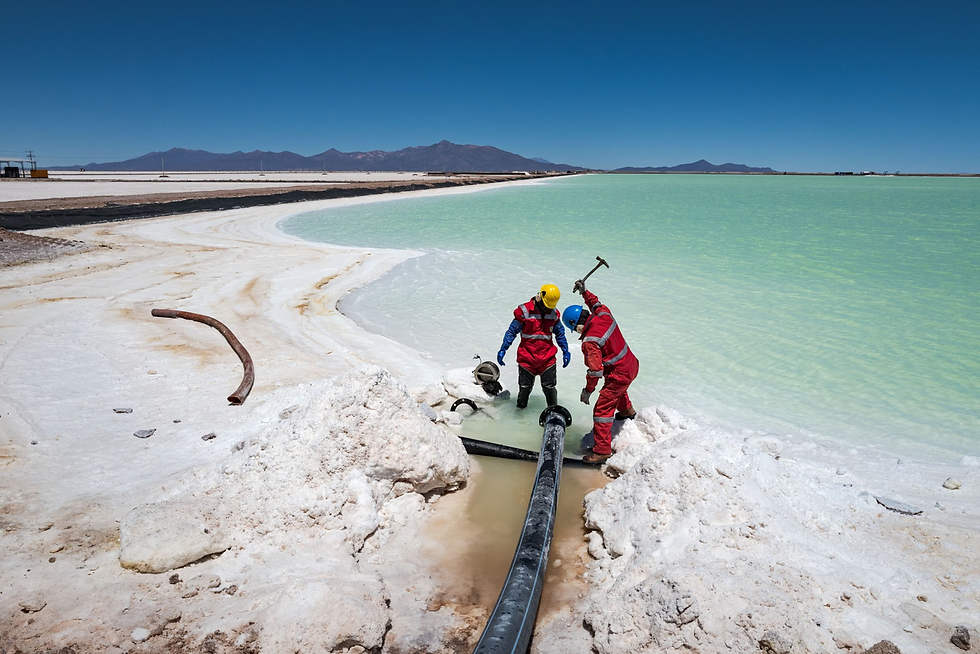Seabed Mining of Manganese Nodules: Unlocking Resources, Unleashing Consequences?
- TechTrek Admin

- Mar 15
- 3 min read
Updated: Apr 22
By Alan Li,
The Peddie School, NJ
Manganese nodules, also called polymetallic nodules, are round rock like formations found at the bottom of the sea worldwide. These nodules contain valuable metals like iron and manganese oxide. Proposed mining of these nodules could have less of an environmental impact than getting the same metals from land based mines.
Manganese nodules vary in size, the smallest ones only being visible under a microscope, and the largest ones being over 20 cm in diameter (8 in). They are mineral concretions on the seafloor, formed of concentric layers of iron and manganese hydroxide, hence their name. Because of their composition, these nodules may also sometimes be referred to as ferromanganese nodules. They are found at depths of anywhere from 3-6 km (2-4 mi) under sea level.

Nodules are formed by natural processes over an unimaginably long time scale, with a growth rate of less than a few millimeters per million years. The process begins with a core, or nucleus. The nucleus can be anything solid, like bone or rock fragments, and is no bigger than a ping pong ball. Layers start to form around the core over time, as metal ions are deposited onto it. There are two methods of growth, being hydrogenetic and diagenetic growth. The former describes metal ions dissolved in seawater, and the latter metal ions dissolved in sediment pore-water (the water in between the sand of the seabed). Both methods are usually used in formation, depending on the region and the surrounding sediment.

Image of a Maganese Nodule mined from the seabed
The reason there is so much interest in these nodules is the high concentration of metals found in them. Copper, nickel, iron, and manganese among other metals, all required to create the products we use. Cobalt, for example, is a rare metal and extracting them through seabed mining of manganese nodules could be an effective way to meet demand.
Since these nodules form over millions of years, similar to how fossil fuels are produced by biological matter from millennia ago, they are not renewable. In the process of deep sea mining, huge collection vehicles the size of trucks scrape across and destroy the seabed in search of nodules. This of course leads to loss of animal life and lasting plough marks on the seafloor. Additionally, many deep sea ecosystems have not been seen by human eyes yet, and the disruption of such ecosystems could have unforeseen consequences.

Image of a seabed collection vehicle
While manganese nodule mining could have negative effects on the environment, the world still requires an ever increasing amount of rare minerals, especially in the development of renewable energy sources such as solar panels and batteries. If these minerals are not mined from the seafloor, demands will be met in other ways. Current mining operations have terrible effects on both the climate of the world and the immediate surroundings of mining sites. Surface mining requires huge amounts of energy, and releases many harmful chemicals and gases into the air. Mining sites also cause air and water pollution to the surrounding settlements, along with exposure to toxins and physical injuries.
Many huge corporations have already started planning large-scale mining operations. We should consider the benefits and costs of seafloor mining, and if its introduction would aid or be helpful or detrimental to our planet
----Works Cited
Katona, Steven, et al. “Ethical Opportunities in Deep‐Sea Collection of Polymetallic Nodules from the Clarion‐Clipperton
Zone.” Integrated Environmental Assessment and Management, vol. 18, no. 3, 16 Dec. 2021,
“Manganese Nodule - an Overview | ScienceDirect Topics.” Www.sciencedirect.com,
“Manganese Nodules - GEOMAR - Helmholtz-Zentrum Für Ozeanforschung Kiel.” Www.geomar.de,
%202_e.png)





Comments